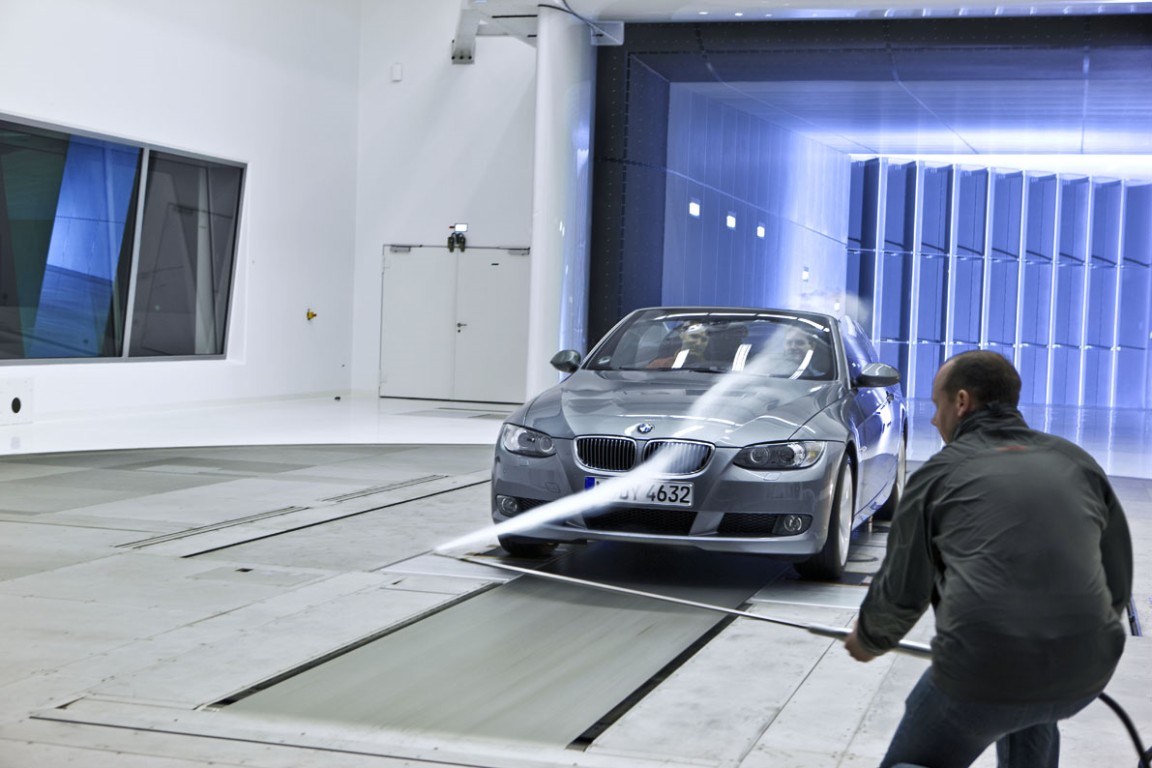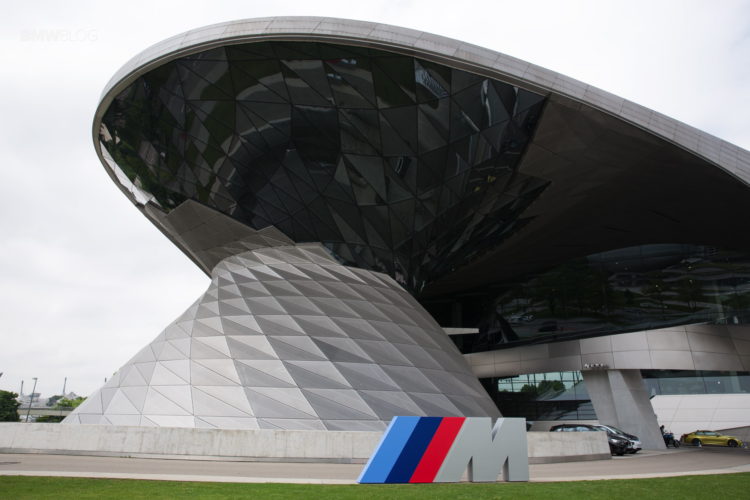An investment in the future: the Aerodynamic Test Centre.
No other car maker is as committed as the BMW Group to making lasting and substantial investments in the enhanced efficiency of new models. Building the new Aerodynamic Test Centre, the BMW Group now has even greater competence and qualifications than before in the area of innovative technologies contributing in the medium and long term to the further improvement of all BMW and MINI models in their fundamental strengths and benefits.
For optimisation of the car’s aerodynamic qualities improves both its performance and efficiency, as well as the driving stability offered by the car on the road. Precisely this is why optimum aerodynamics is already a fundamental factor today in the development of new models.
Building the ATC, the BMW Group is giving even greater emphasis to the ongoing enhancement of aerodynamics as an essential cornerstone of the EfficientDynamics philosophy. Optimised aerodynamics have a direct impact on the car’s fuel economy and emission management, a reduction of air drag by 10 per cent offering the customer a reduction in fuel consumption on the road by more than 2.5 per cent – and even such an at first sight “insignificant” improvement is of great importance to the BMW Group as part of an overall package for the enhancement of efficiency.
With BMW Group cars already offering excellent aerodynamic qualities today, further improvement and, indeed, optimisation, calls for a substantial investment. So making such an investment in the ATC, the BMW Group clearly expresses its intention to use all facilities also in future in order to improve both fuel economy and emission management to an even higher standard.
The ATC offers new options and potentials in analysing the aerodynamic qualities of a car – and at the same time flexible processes applied at the ATC as well as its location in the immediate vicinity of the BMW Group’s Research and Innovation Centre (FIZ) optimises the integration of all activities in the overall process of vehicle development. In future, therefore, the BMW Group’s aerodynamic specialists will be working next door and hand-in-hand with BMW’s designers, constructors, engine specialists and other experts.
Over and above such enhanced integration into the development process, the ATC has facilities and capabilities unique the world over in determining aero-dynamic features and qualities in a truly realistic process. One option, for example, is to analyse new models at a very early stage of development in a wide range of different situations with all test scenarios following real-life driving conditions. This means not only the consideration of all kinds of speed ranges, but also different driving situations such as driving in a bend, taking the actual movement of the body into account.
A further point is that the ATC is now able for the first time to render and analyse the interaction of a car with other vehicles, for example when overtaking, thus offering yet another new benefit in the development of production cars.
So far such tests could only be conducted on the test track, with cars almost completely developed in every respect. Now the knowledge gained in this process can be fed back into the development process much earlier, serving to effectively optimise a new model right from the start.
Most advanced wind tunnel technology for realistic measurements.
The BMW Group’s new Aerodynamic Test Centre is the world’s most modern facility of its kind throughout the entire automotive industry. The ATC comprises a wind tunnel serving to analyse vehicles in their original size. To reproduce the most important effects and phenomena when driving on the road, the road surface is modelled through a simulation process using no less than five rolling tracks.
A second wind tunnel allows the engineer to move the models tested from one position to the other by means of a control system operating in all directions above the world’s largest rolling road in a wind tunnel. This serves to analyse vehicle flow conditions under all kinds of circumstances, applying a concept already used for a number of years in motorsport. Now, therefore, aerodynamics and driving dynamics may interact and be combined with one another also in the development of production cars.
The number of scenarios available as well as the precision of the test processes applied at the ATC offer a standard quite unique for a facility of this kind. Both wind tunnels, to mention just one example, are able to generate an air flow velocity of up to 300 km/h or 186 mph, for the first time providing exactly the right, correct physical conditions for the measurement of true-to-scale models.
In all, the BMW Group has invested some Euro 170 million in the construction of the Aerodynamic Test Centre and the facilities/equipment used. Within about three years, the five-floor building constructed on a piece of land measuring approximately 25,000 square metres or 6.2 acres has been completed in the immediate vicinity of the Munich FIZ Research and Innovation Centre and boasts architecture quite unique at very first sight, providing a clear hint from the beginning that the technology used inside is very special indeed.
One example of this distinctive look and architecture is the round contour of the fan for the horizontally arranged air flow ring in the main wind tunnel clearly recognisable on the southern side of the building. The vertical air flow ring for the model wind tunnel, in turn, likewise stands out clearly in the centre of the ATC.
BMW’s EfficientDynamics specialists focusing in the ATC specifically on aerodynamics used to work at no less than five different locations before moving into the new Test Centre, travelling up to 20 kilometres in order to work together in the wind tunnel. Now, by putting all these specialists together in one building, the BMW Group ensures direct contact with extremely small distances between the various specialists and has established new processes for highly efficient interaction and cooperation. In all, some 500 specialists in BMW EfficientDynamics will be working together in the new building.
Even more efficient: new generation of straight-six power units with turbocharger technology.
Together with the new ATC, BMW is proudly presenting the latest results in the development of particularly powerful and, at the same time, impressively economical straight-six power units. Indeed, these new engines, whether running on gasoline or diesel fuel, offer a significantly better balance of fuel economy and superior performance than ever before – quite simply, because both engines use special technologies developed by BMW to enhance both efficiency and dynamic performance. Both power units therefore offer the same kind of momentum and superiority in the development of power otherwise provided only by a much larger eight-cylinder, while at the same time they are naturally much lighter and offer substantially better fuel economy and emission management.
BMW’s new TwinPower Turbo gasoline engine developing 225 kW/306 hp for the first time combines turbocharging, direct fuel injection and fully variable valve management in one drive unit. This combination of a twin-scroll turbocharger with High Precision Injection and VALVETRONIC exclusive to BMW gives the new engine fully suited for the world market not only unusually spontaneous and direct behaviour, but also exceptionally low fuel consumption and emission ratings.
This 3.0-litre six-cylinder develops its maximum torque of 400 Newton-metres or 295 lb-ft at an engine speed of just 1,200 rpm and then maintains this superior torque level all the way to 5,000 rpm. In comparison with the straight-six featuring Twin Turbo technology and High Precision Injection already featured in several model series, the engine at the same time offers a further reduction of fuel consumption by up to 9 per cent.
Introducing an additional top version of the six-cylinder diesel already featured in the BMW 730d and the BMW 330d, BMW once again proves the outstanding potential this engine technology has to offer. Again, the new generation of BMW’s straight-six diesel, combining multi-stage turbocharging with common-rail direct fuel injection, offers fascinatingly dynamic power and performance with maximum efficiency. And again in the spirit of BMW EfficientDynamics, numerous innovations on the all-aluminium engine as such, the two turbochargers and the injection system ensure a significant increase in power as well as a further reduction of fuel consumption and emissions. Not only the turbocharger system is even more efficient than before, but also the supply of fuel through piezo-injectors operating at an injection pressure of up to 2,000 bar.
The new 3.0-litre BMW TwinPower Turbo diesel delivers maximum output of 225 kW/306 hp at an engine speed of 4,400 rpm, with peak torque of 600 Newton-metres/442 lb-ft at just 1,500 rpm. These figures alone allow the new engine to take over the leading position from its own predecessor as the most sporting and dynamic six-cylinder diesel in the world, at the same time offering some 4 per cent lower fuel consumption and CO2 emissions.
BMW’s new eight-speed automatic transmission: the intelligent way to more gears, greater efficiency and enhanced driving dynamics.
BMW’s new eight-speed automatic transmission is yet another example of how outstanding engineering qualities are able to offer a significant improvement in driving pleasure and, at the same time, far greater efficiency than ever before.
This innovative power transmission first introduced in the twelve-cylinder BMW 760i and BMW 760Li excels in particular through its exceptional efficiency and wide range of qualities. At the same time, through its special characteristics, the new eight-speed transmission raises both the motoring comfort and the dynamic performance of the respective model to an even higher standard.
Yet a further important point is that this significant progress over BMW’s six-speed automatic transmissions already lauded the world over for their superior gearshift dynamics and efficiency has been achieved in a particularly intelligent manner. The two additional gears give the entire transmission an even broader range of increments and, at the same time, keep the change in engine speed when shifting from one gear to the other even smaller than before. Thanks to the innovative configuration of the gearsets, the number of additional components required and, accordingly, the weight of the new eight-speed automatic transmisson, has been reduced to a minimum.
Converter slip limited to the lowest range of engine speeds, a high degree of inner efficiency, low frictional losses with only two clutches open at a time, the longer transmission ratio of the higher gears, and the improved suppression of vibrations enabling the driver to use the car much more at low speeds, help to reduce fuel consumption versus the former six-speed automatic transmission by approximately 6 per cent.
A further important point is that the eight-speed automatic transmission enhances the dynamic qualities of the engine by opening and closing only one clutch at a time in nearly all gearshifts, even when shifting down by more than one gear. This offers an important benefit so far provided only by the double-clutch gearbox and combined in this case with all the benefits of an automatic transmission relevant to the customer, such as dynamic acceleration from low engine speeds.
The new eight-speed automatic transmission is also a particularly future-oriented solution for the transmission of power in a premium car. It may be combined with all kinds of engines varying in their design and performance, being used not only in cars with rear-wheel drive, but also in all-wheel-drive models. And at the same time the eight-speed automatic transmission also has all the qualities to form a perfect combination with hybrid drive. This alone ensures a unique blend of efficiency and dynamism on a brand-new level, proving that this concept perfectly suited for the future will be heading for success after reaching production level in the course of 2009.
The new options offered by BMW’s Aerodynamic Test Centre, together with current and future innovations in drivetrain technology, will serve on many occasions to solve the conflict of interests between growing dynamics and optimised economy in all segments of the market. As a result, therefore, the BMW Group has an even better position than ever before in developing cars for the future which, through their design and driving qualities, will offer a fascinating driving experience combined with equally supreme fuel economy and emission management.
For more details, you can download this PDF.








































































